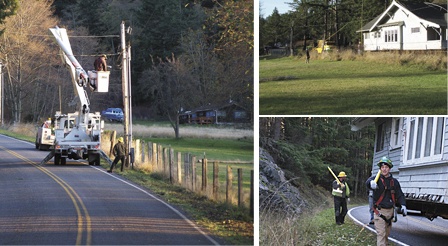Fiona and Edward Stone were elated when they found the house.
“Its historical significance was amazing and its interesting lines validated the reason for salvation. The house was relatively original and is a great candidate for refurbishing,” Fiona said.
With the help of Nickel Brothers and OPALCO, the Orcas couple moved a 1912 Craftsman bungalow, originally from the Seattle area and destined for demolition, to their property in Olga on Dec. 1.
The home was transported by barge to Obstruction Pass, loaded onto a trailer and delivered. The OPALCO crew dropped some lines, then pulled – or raised – lines out of the way along its route. There were no power outages taken. Coincidentally, Fiona has been working as a temporary employee at OPALCO for the past six weeks.
“It’s not the first time we’ve helped to move a house – but it doesn’t happen very often,” OPALCO Foreman Steve Eyler said.
The “Corliss Home” was built in 1912 by Edward L. Merritt, the owner and architect for the Craftsman Bungalow Company. He and his partner in the firm, Jud Yoho, both owned the property.
“It demonstrates the degree to which Asian architecture influenced the design of houses built in this style,” Fiona said. “Perhaps of even more significance, however, is the fact that the Craftsman Bungalow Company was the owner of the property on which this house was built. The house was listed under historical sites in Wallingford, Seattle due to the significance. It was destined for demolition in 2008.”
The house is now on the Stones’ property, which has been in Edward’s family for three generations.
“When the project is complete it will look like it has been there since 1912,” Fiona said.
The Stones thanked Nickel Brothers for an “amazing move,” OPALCO for being “so supportive and innovative,” historical preservationist Jeff McCord, Teri Williams, and the community for being “so responsive and understanding in regards to the principal of restoration rather than renovation” of historic houses.
“By saving them we leave a greener footprint and a preserves a little piece of history,” Fiona said.




